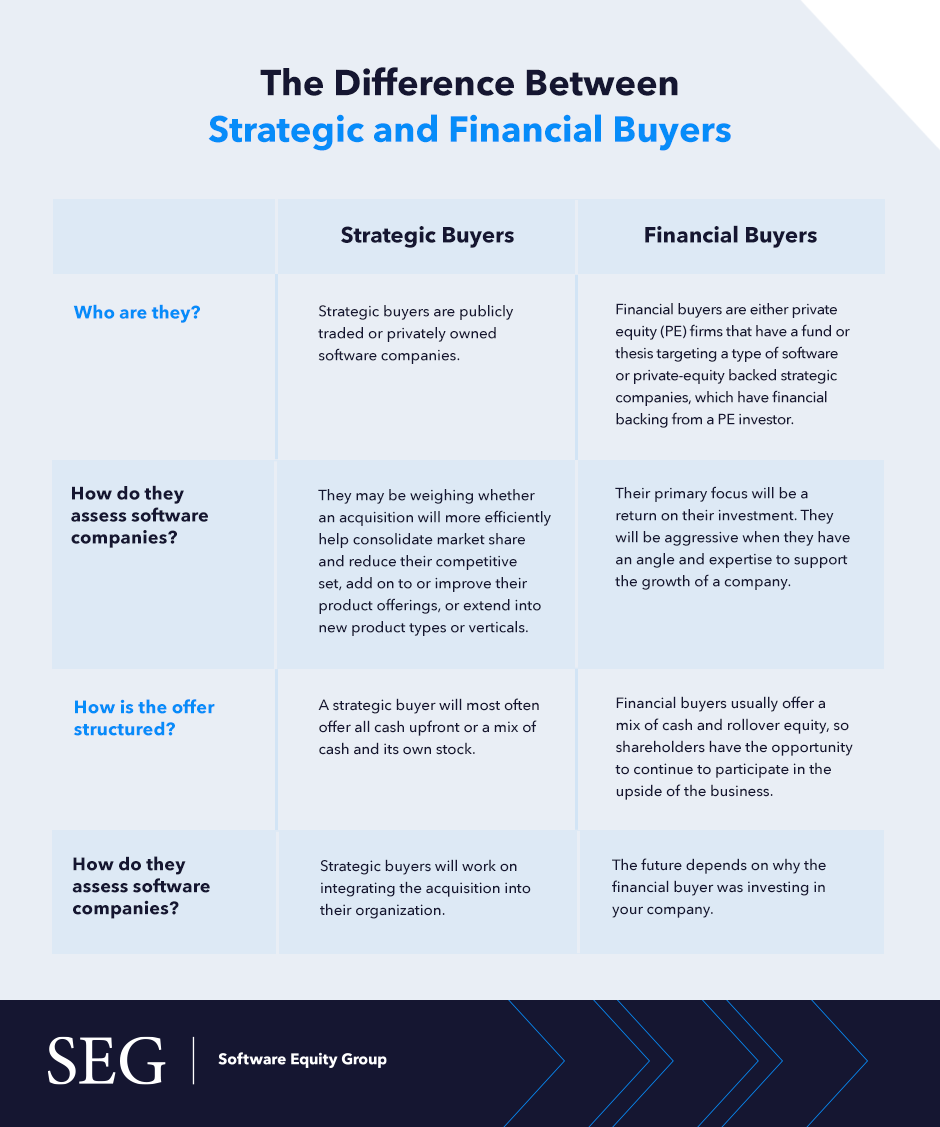Strategic vs Financial Buyers: A Look at The Top Differences During M&A

Making the decision to sell a company is a big one. It’s a bit like a marriage – from initially meeting potential partners to making the decision to commit to just one, it can be a complex and emotional process. Selecting a partner is a big milestone that marks the beginning of a lot of planning, communication, and organization to make sure the marriage will help you both get what you want and need.
Like a marriage, selling your business is a long-term commitment. To get the best results, you need to go into the process knowing what your goals are for a sale. Part of this is understanding what types of companies will be interested in acquiring or investing in your business and what potential offers will look like from different types of buyers. With record amounts of deployable capital behind them, private equity (PE) investors account for nearly 60% of mergers and acquisitions (M&A) deals in tech today. Do you understand the different categories of buyers, including private equity investors, and how they differ from one another?
While you’ve likely thought about what you’d want to get out of selling your company, you never know what will happen until you really hit the market. It’s important to understand the different types of buyers before you begin the sales process so you can have a better foundation for evaluating offers.
When looking at an M&A acquisition, there are two types of main buyers: strategic and financial. Both offer numerous benefits for companies in an M&A process depending on your personal and business objectives in a transaction, and each offers unique post-transaction opportunities for their acquisition targets.
Let’s look at the difference between strategic buyers and financial buyers, what you should know about each, and why each option could be a good fit depending on your goals for selling your company.
Understanding the Difference Between Strategic and Financial Buyers
There are several kinds of buyers, but most can be grouped into two categories: financial buyers and strategic buyers. When you’re selling your company, both represent appealing options, depending on what you want to get out of the sale.

Strategic buyers
These types of buyers run the gamut; they can be publicly traded or privately owned software companies. Strategic buyers are looking to acquire companies in a way that helps progress their own business goals. They may be weighing whether an acquisition will more efficiently help consolidate market share and reduce their competitive set, add on to or improve their product offerings, or extend into new product types or verticals. These buyers typically acquire companies to integrate into their operations (though in some cases, acquisitions are kept separately).
Due to strategic buyers having synergies and business rationale for making acquisitions, they have historically paid higher valuation multiples than financial buyers. However, this dynamic has shifted in recent years.
Financial buyers
For the majority of software M&A events, these types of buyers are private equity (PE) firms that often have a fund or thesis targeting a type of software, and in many cases specific verticals within software. Or they can be private-equity backed strategic firms, a company that has financial backing from a PE investor. This capital from the PE is specifically earmarked for growth.
Financial buyers typically have a portfolio of companies already purchased within software that they invest in, assist in operating, and then eventually exit by selling the business to another party. Some financial buyers will be interested in a company as a way to start gaining experience for a new portfolio.
Financial buyers will look to re-sell the company in the short term (five to seven years) and will work with newly acquired companies to continue to build the business and assist in achieving the company’s goals. Within a portfolio, financial buyers will use the experience and organization strategies across multiple companies to add leadership, like a new CEO or other expert within the management team, and focus their efforts on growth.
Which is right for your company?
Historically, you may have gotten a higher offer from a strategic buyer, but this is changing. Now a major difference between a strategic buyer or a financial buyer is the type of offer you’ll receive. A strategic buyer will most often offer all cash upfront or a mix of cash and its own stock. A financial buyer like a PE firm or PE-backed strategic buyer will usually offer a mix of cash and rollover equity so that shareholders have the opportunity to continue to participate in the upside of the business, we call it a second bite of the apple for founders.
Financial buyers (like private equity firms) are becoming more aggressive. There has been a growing trend for PE investors looking for SaaS and software companies. These types of companies have become incredibly attractive as an investment asset class. The PE industry has shifted toward a more growth-oriented mindset — less the classic leveraged-buyout in the 80s, 90s, and early aughts where they buy a company and slash costs, and more an investment for growth by putting money back into the companies they’ve purchased.
As a result of that, there is a record amount of capital right now that has been raised to purely invest in SaaS. It’s called dry powder. SaaS has been an incredibly attractive asset class for PEs to invest in where they had really strong outcomes to invest in.
Additionally, financial buyers are becoming more aggressive because of the rise of a new type of buyer: PE-backed strategic buyers. These are strong strategic companies that are backed by a PE buyer. They look at M&A as a way to drive investments. They are interested in companies where they can help operations, improve the management team, and do better on sales and marketing. In many cases, the strategy is that they think they can fund more acquisitions.
These PE-backed strategic buyers have capital set aside for that company to go buy additional products, it’s part of their plan to build, using M&A as a main growth objective. These PE companies are driving a large number of acquisitions from their portfolio companies. They have capital to make purchases, use M&A as part of their business strategy, and they can move fast and lean in on a purchase.
Choosing which type of buyer will be right for your company will depend on what you’d like to get out of the deal in the future. What do you want your (and the executive team’s) roles to look like post-transaction? What are existing shareholders seeking from a sale? Are they looking for a full or partial exit?
And you need to decide how the offer meshes with the long term vision of the company. As you keep that long-game in mind, you can determine what is important for your company after the sale and what management will need to support the vision, what the industry landscape will look like, and what the opportunity will be for your business within a larger strategic organization.
Let’s look at some of the things strategic buyers vs. financial buyers get excited about when looking at prospective companies.
How Different Buyers Evaluate Companies
Understanding the right type of buyer for your company really depends on what you’re looking to get out of the sale. You might seek out a strategic buyer because you want to find a place where your company will add value and benefit a current market.
Or maybe you want to look at financial buyers. PE’s view M&A through the lens of generating a return on investment, giving them a different set of priorities than strategic buyers.
Because of these two very different end goals for the buyers, each buyer type approaches M&A in unique ways, looking for different qualities in a potential acquisition.
How strategic buyers approach an acquisition.
Strategic buyers are looking at companies they can acquire as a way to add long-term value. Sometimes this means they want to address a weakness in their offering, or they may need help entering a new market. This was the case when Salesforce purchased Slack. Salesforce was making a bet that consumers wanted a seamless experience from their tech stack and communication tools. Rather than putting resources into Salesforce’s own communication tool and building out features that rivaled Slack’s ease of use, they decided to purchase a company with a well-established user base and extensive collaboration features and get a head start on the market.
Strategic buyers look for synergies when evaluating a purchase. They’re evaluating cost and revenue synergies, seeing where they can reduce costs or increase revenue immediately once they acquire a company. They also look for product overlaps and how acquiring a company can help them better serve existing customers or acquire new ones.
Strategic buyers also look at M&A as a way to open up new verticals. Strategic buyers like Salesforce evaluated the ROI of building internally vs. purchasing and decided the option to purchase made more sense for their long-term financial goals. Here are a few additional things strategic buyers look for when evaluating a company:
- The technical strengths of the product
- The management team and employees and their strengths and potential
- Delivery model (Are you a cloud service or an on-premises product?)
- The quantitative aspects of your business like ARR, growth forecasts, recurring revenue, and more
- Whether the industry is growing, contracting, or plateaued
- Where there are synergies in operations
How financial buyers approach an acquisition.
No matter the type of financial buyer, many are looking for similar characteristics when approaching an acquisition, including the opportunity for a financial return and ways to maximize valuation in the short term.
In the past, financial buyers had one simple motivation: buy low and sell high. But now, because the marketing for tech companies has become so valuable, this is changing. When financial buyers feel they have an angle and expertise to support growth of a company, they will be more aggressive in their offer to win the business and get a return on their money. Financial buyers are facing more competition, so they have to find a way to win in a hot M&A market. Sometimes they’ll pay a price higher than what financial sponsors are comfortable with just to play the game.
But as they approach an acquisition, their primary focus will still be a return on their investment.
Strategic vs. Financial Buyers: Post-Acquisition
After acquisition, things tend to play out a little differently between different buyer types. While each deal and business is unique, there are some things you can expect after the deal is done.
What happens in a company after a purchase by a strategic buyer?
Immediately after acquisition, strategic buyers will work on integrating the acquisition into their organization. The level of this integration depends on the strategic buyer and their plan for post-transaction — in some cases, the company is integrated into the broader product offering of the acquirer, and in some cases it may be let alone to continue operating with some basic support and management. This can include marketing products to an expanded customer base or eliminating costly redundancies.
What happens in a company after a purchase by a financial buyer?
The future depends on why the financial buyer was investing in your company. Is your company a platform investment or an add-on to an existing portfolio company? Their goals will impact how they approach the post-M&A process. Some will push to maximize profit quickly. Other buyers can dedicate an operations team to help build the business without investing any primary capital outside of the money required to buy the business. Others will add an investment of capital to help the company begin to scale operations.
Depending on the dynamics of the deal and what you want for your company, a PE investor can leave the leadership team in place. Some PE investors focus on a niche where they work with companies whose management teams are ready to leave after the acquisition and the PE investors bring in an industry expert to lead the company as the founder decides to step into a board role. This is why it will be important to have an M&A partner in place to navigate your deal to ensure you know what to expect from the process and the types of offers you’ll receive for your company.
Use an Expert Team to Help You Through the Process
Every M&A transaction is different and each deal has many layers of unique complexity. This is why it’s beneficial not to approach a sale on your own. Get a trusted advisor to help you work through the process.
Software Equity Group (SEG) has been in the business of advising software companies for more than 30 years, helping entrepreneurs sell their businesses to both strategic and financial buyers. Because of our experience in the market, we’ve seen buyer dynamics shift over time and know how to work with the evolving set of strategic buyers and investors.
SEG takes a hands-on approach by partnering with business leaders to help them understand the dynamics of different buyers and what their options for pursuing a transaction are. We help to answer questions and leverage our relationships in the industry to support your company through the entire M&A process. Working with SEG will ensure you get a tailored approach to achieving the best possible outcome for your company.
Considering a sale? Get in touch with us to learn more about how to navigate an acquisition that will meet your goals.









